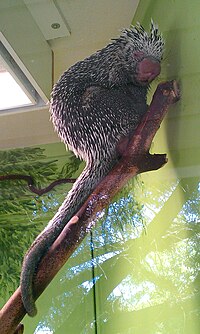
The New World porcupines, family Erethizontidae, are large arboreal rodents, distinguished by their spiny coverings from which they take their name. They inhabit forests and wooded regions across North America, and into northern South America. Although both the New World and Old World porcupine families belong to the Hystricognathi branch of the vast order Rodentia, they are quite different and are not closely related.
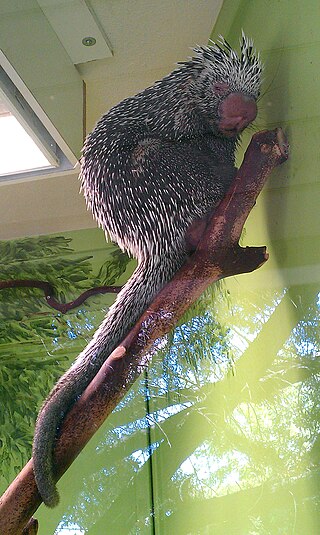
The Brazilian porcupine is a porcupine found in Brazil, Argentina, Uruguay, Colombia, Venezuela, Guyana, French Guiana, Peru, Paraguay, Suriname, Bolivia and Trinidad, with a single record from Ecuador. It inhabits tropical forests at elevations up to 1500 m.
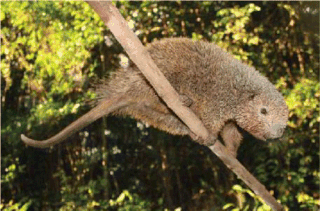
The bristle-spined rat is an arboreal rodent from the Atlantic forest in eastern Brazil. Also known as the bristle-spined porcupine or thin-spined porcupine, it is the only member of the genus Chaetomys and the subfamily Chaetomyinae. It was officially described in 1818, but rarely sighted since, until December 1986, when two specimens - one a pregnant female - were found in the vicinity of Valencia in Bahia. Since then it has been recorded at several localities in eastern Brazil, from Sergipe to Espírito Santo, but it remains rare and threatened due to habitat loss, poaching and roadkills.
The dwarf hutia is a small, critically endangered, rat-like mammal known only from Cuba. Aside from tracks, it was last seen in 1937 and may be extinct. It gives birth to only a single offspring at a time, and is threatened by habitat loss and non-native species such as rats and mongoose. The dwarf hutia belongs to the hutia subfamily (Capromyinae), a group of rodents native to the Caribbean that are mostly endangered or extinct.
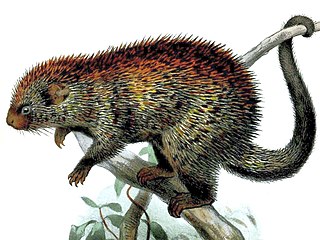
The Paraguaian hairy dwarf porcupine is a porcupine species from the family Erethizontidae. It is found in Argentina, Brazil, Paraguay and Uruguay.

The black-tailed hairy dwarf porcupine is a porcupine species from the family Erethizontidae. It is found in Brazil, Colombia, Ecuador, French Guiana, Guyana, Suriname and Venezuela.
The Bahia porcupine, is a New World porcupine species in the family Erethizontidae endemic to the Atlantic Forest of southeastern Brazil. It was formerly sometimes assigned to Sphiggurus, a genus no longer recognized since genetic studies showed it to be polyphyletic. Sphiggurus pallidus, formerly considered a separate species but known from two young specimens only, is a synonym of this species.
Roosmalen's dwarf porcupine is a porcupine species from the New World porcupine family likely endemic to northern Brazil. Only three specimens were known at the time, and only one had a collection locality. It is named for Marc van Roosmalen and his son Tomas, whose collections from the middle Madeira included the first known specimens. It was soon assigned to the genus Sphiggurus, although this genus was not recognized by the authors. Genetic studies in 2013 have since showed Sphiggurus to be polyphyletic. Nonetheless it is commonly classified as Sphiggurus roosmalenorum. Coendou roosmalenorum may be misspelled due to a conflicting basionym combination.

The black dwarf porcupine, also known as Koopman's porcupine, is a porcupine species from the New World porcupine family endemic to northern Brazil. It occurs in the Amazon rainforest east of the Madeira River and south of the Amazon River. It inhabits primary forest and possibly second growth. It was described as Coendou koopmani by Charles O. Handley Jr. and Ronald H. Pine in 1992, but was subsequently found to be identical to a species described in 1818. It is nocturnal and herbivorous.

The hairy Atlantic spiny rat is a spiny rat species from South America. It is endemic to Brazil.

The bicolored-spined porcupine is a species of nocturnal and arboreal rodent in the family Erethizontidae. It is found in Bolivia, Colombia, Ecuador, and Peru.

The stump-tailed porcupine is a species of rodent in the family Erethizontidae. It is found mainly in Colombia, with a few records from Ecuador.
Makalata is a genus of rodents in the family Echimyidae.
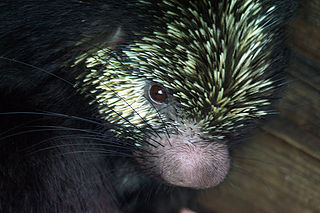
The Mexican hairy dwarf porcupine or Mexican tree porcupine is a species of rodent in the family Erethizontidae. It is found in Costa Rica, El Salvador, Guatemala, Honduras, Panama, Mexico, Nicaragua and Belize.

The brown hairy dwarf porcupine is a species of rodent in the family Erethizontidae. Found in the Andes in Colombia and Venezuela, its natural habitat is subtropical or tropical moist lowland forests. It is not easy to study as it is only known from a few specimens and wasn't recorded from 1925 until the 2000s. The porcupine is nocturnal and arboreal, feeding on leaves, shoots, and fruits. Habitat loss severely threatens it and it may even be extinct. Formerly listed as vulnerable, it is now designated data deficient. It is not known from any protected areas or conservation measures.

The streaked dwarf porcupine is a porcupine species in the family Erethizontidae. It is known from the lowlands of eastern Ecuador, and may be present in Peru as well. It appears to be nocturnal and arboreal in its habits.
The frosted hairy dwarf porcupine is a porcupine species in the family Erethizontidae from Colombia and northern and eastern Venezuela. It was formerly sometimes assigned to Sphiggurus, a genus no longer recognized since genetic studies showed it to be polyphyletic. The species lives in lowland tropical rainforest and cloud forest at elevations from 50 to 2,600 meters. Its karyotype has 2n = 42 and FN = 76. Its closest relative is the brown hairy dwarf porcupine.

The Andean porcupine or Quichua porcupine is a species of rodent in the family Erethizontidae. It is found in the Andes of northern Ecuador and Colombia as well as in Panama. This porcupine is little known, but is probably arboreal, nocturnal and solitary like its relatives. The species is thought to be uncommon to rare and the population decreasing. It is threatened by deforestation, habitat fragmentation and agriculture.

The Santa Marta porcupine is a rodent in the family Erethizontidae. It is known from dry forests on the lower slopes of the Sierra Nevada de Santa Marta and Serranía del Perijá mountains of northern Colombia, at altitudes below 500 and 1100 m, respectively, and intervening lowlands, and may also be present in nearby parts of Venezuela. It has been described as a subspecies of C. prehensilis, although the latter may be a species complex. Its karyotype has 2n = 74, FN = 82.

Echimyidae is the family of neotropical spiny rats and their fossil relatives. This is the most species-rich family of hystricognath rodents. It is probably also the most ecologically diverse, with members ranging from fully arboreal to terrestrial to fossorial to semiaquatic habits. They presently exist mainly in South America; three members of the family also range into Central America, and the hutias are found in the West Indies in the Caribbean. Species of the extinct subfamily Heteropsomyinae formerly lived on Cuba, Hispaniola, and Puerto Rico in the Antilles.
